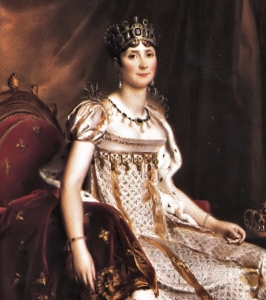Joséphine de Beauharnais
Marie–Josèphe–Rose Tascher de La Pagerie (Les Trois–Ilets, Martinique, 23 June 1763 – Paris, 29 May 1814), better known as Joséphine de Beauharnais from the name of her first husband, was married to Napoléon Bonaparte from 1796 to 1809.
Born in Martinique to a family of French landowners, Joséphine became engaged at a young age to the nobleman Alexandre de Beauharnais, able to ensure clear economic benefits for the de La Pagerie family, which was experiencing economic difficulty at the time. The pair married in 1779 and had two children, Eugène and Hortense, but due the events of the French Revolution, Alexandre was guillotined in 1794.
Shortly after, Joséphine met Napoleon for the first time, then a young general for whom one predicted a glorious career. The two soon began a relationship and in 1796, just before Napoleon departed for the Italian Campaign, they married. Joséphine thereby became the wife of the future emperor, and she herself would be crowned, by the hands of her spouse, at Notre Dame in 1804. During the years of the first consulate and then the empire, Joséphine, with a refined elegance conquered during her first marriage, influenced fashion and customs and played a role of the highest prominence in the artistic and cultural life of the country, transforming her residence at Malmaison into a temple dedicated to the muses.
In 1809, Napoleon concluded a period of progressive estrangement with a request for divorce, motivated by the need to give France an heir, which his marriage to Joséphine had been unable to produce. Malmaison then became Joséphine’s refuge during the last years of her life. She died in 1814 due to complications from a cold.










